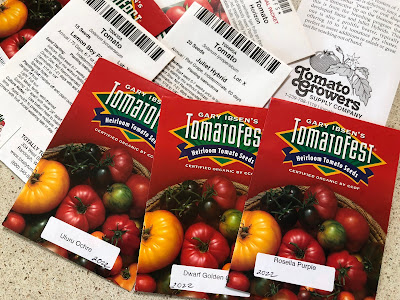
Stay warm inside and plant seeds

|
|
Dwarf varieties are among my tomato seed
purchases this year. (Photo: Kathy Morrison)
|
When it's so cold outdoors this week, it's nice to think of warmer days and summer vegetables.
There's still plenty of time to start seeds for tomatoes and other summer favorites. For a little extra help, check out an online Zoom class this weekend, presented by the Solano County master gardeners.
"Starting Seedlings for Summer, Even When It's Cold Outside" will be hosted by master gardener Alex Russell, 10 a.m. to 11 a.m. Saturday, Feb. 26. The Zoom link is here .
Last year I started all my tomatoes in late January and early February. Three weeks later, several had collapsed from inattention (I had a busy winter!) and I had to start them again -- what a waste of seeds and time. With a trip planned in the middle of the month this year, I decided to delay my seed-starting until after I returned.
The tomatoes include my favorites, Juliet, Big Beef and Lemon Boy, while this year's experiments include some of the new dwarf heirloom tomato varieties developed by the Dwarf Tomato Project and sold on the TomatoFest online store. The link will take you to a detailed description of the project, which started in 2005. For the seed listings, go here.
The distinction between dwarf tomatoes and compact determinate ones is important: The flavor apparently is better, and "these dwarf types are very distinctive in having a thick central stem, stout compact growth, and dark green, crinkly looking (so-called rugose) foliage." They top out at 3 to 4 feet in height, apparently.
This project has produced 30 varieties of open-source seeds. Many gardeners have limited space for tomatoes, so I'll be interested to see how these grow out in a Sacramento summer. I bought seeds for 4 varieties:
-- Uluru Ochre, 65 days, a 6- to 12-ounce "uniquely colored" orange-black tomato (SF Giants colors!). Indeterminate.
-- Dwarf Hannah's Prize, 75 days, 6- to 12-ounce, red with some light striping.
-- Dwarf Golden Gypsy, 75 days, 8- to 18-ounce, yellow-gold. Indeterminate.
-- Rosella Purple-Dwarf, 78 days, 6- to 12-ounce purple-black (similar to Cherokee Purple). Indeterminate.
Stay tuned this year for progress reports on these varieties.
Comments
0 comments have been posted.Sacramento Digs Gardening to your inbox.
Sites We Like
Garden Checklist for week of May 12
Get your gardening chores and irrigation done early in the day before temperatures rise.
* Plant, plant, plant! It’s prime planting season in the Sacramento area. Time to set out those tomato transplants along with peppers and eggplants. Pinch off any flowers on new transplants to make them concentrate on establishing roots instead of setting premature fruit.
* Direct-seed melons, cucumbers, summer squash, corn, radishes, pumpkins and annual herbs such as basil.
* Harvest cabbage, lettuce, peas and green onions. This heat will cause leafy greens and onions to flower; pick them before they bolt.
* In the flower garden, direct-seed sunflowers, cosmos, salvia, zinnias, marigolds, celosia and asters.
* Plant dahlia tubers. Other perennials to set out include verbena, coreopsis, coneflower and astilbe.
* Transplant petunias, marigolds and perennial flowers such as astilbe, columbine, coneflowers, coreopsis, dahlias, rudbeckia and verbena.
* Keep an eye out for slugs, snails, earwigs and aphids that want to dine on tender new growth.
* Feed summer bloomers with a balanced fertilizer.
* For continued bloom, cut off spent flowers on roses as well as other flowering plants.
* Got fruit trees? If you haven't already done so, thin orchard fruit such as apples, peaches, pears, pluots and plums before they grow too heavy, breaking branches or even splitting the tree. Leave the largest fruit on the branch, culling the smaller ones, and allow for 5 to 6 inches (or a hand's worth) between each fruit.
* Thin grape bunches, again leaving about 6 inches between them. For the remaining bunches, prune off the "tail" end, about the bottom third of the bunch, so that the plant's energy is concentrated in the fruit closest to the branch.
* As spring-flowering shrubs finish blooming, give them a little pruning to shape them, removing old and dead wood. Lightly trim azaleas, fuchsias and marguerites for bushier plants.
* Add mulch to the garden to help keep that precious water from evaporating. Mulch also cuts down on weeds. But don’t let it mound around the stems or trunks of trees or shrubs. Leave about a 6-inch to 1-foot circle to avoid crown rot or other problems.